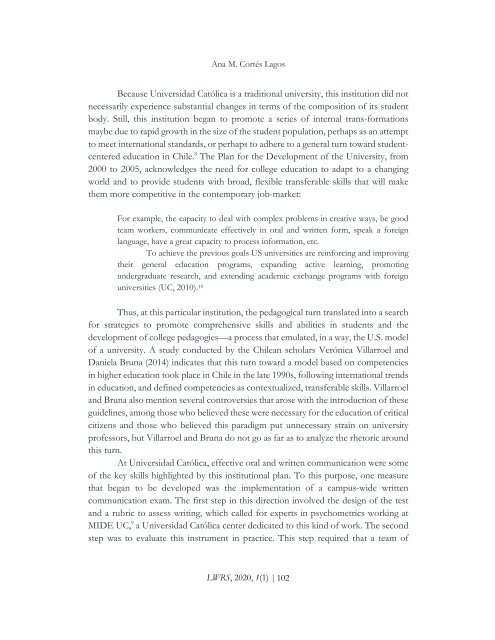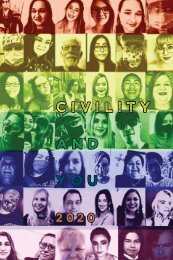LWRS June 2020 Volume 1, Issue 1
Inaugural Issue co-edited by Yndalecio Isaac Hinojosa and Isabel Baca
Inaugural Issue co-edited by Yndalecio Isaac Hinojosa and Isabel Baca
You also want an ePaper? Increase the reach of your titles
YUMPU automatically turns print PDFs into web optimized ePapers that Google loves.
Ana M. Cortés Lagos<br />
Because Universidad Católica is a traditional university, this institution did not<br />
necessarily experience substantial changes in terms of the composition of its student<br />
body. Still, this institution began to promote a series of internal trans-formations<br />
maybe due to rapid growth in the size of the student population, perhaps as an attempt<br />
to meet international standards, or perhaps to adhere to a general turn toward studentcentered<br />
education in Chile. 8 The Plan for the Development of the University, from<br />
2000 to 2005, acknowledges the need for college education to adapt to a changing<br />
world and to provide students with broad, flexible transferable skills that will make<br />
them more competitive in the contemporary job-market:<br />
For example, the capacity to deal with complex problems in creative ways, be good<br />
team workers, communicate effectively in oral and written form, speak a foreign<br />
language, have a great capacity to process information, etc.<br />
To achieve the previous goals US universities are reinforcing and improving<br />
their general education programs, expanding active learning, promoting<br />
undergraduate research, and extending academic exchange programs with foreign<br />
universities (UC, 2010). 10<br />
Thus, at this particular institution, the pedagogical turn translated into a search<br />
for strategies to promote comprehensive skills and abilities in students and the<br />
development of college pedagogies—a process that emulated, in a way, the U.S. model<br />
of a university. A study conducted by the Chilean scholars Verónica Villarroel and<br />
Daniela Bruna (2014) indicates that this turn toward a model based on competencies<br />
in higher education took place in Chile in the late 1990s, following international trends<br />
in education, and defined competencies as contextualized, transferable skills. Villarroel<br />
and Bruna also mention several controversies that arose with the introduction of these<br />
guidelines, among those who believed these were necessary for the education of critical<br />
citizens and those who believed this paradigm put unnecessary strain on university<br />
professors, but Villarroel and Bruna do not go as far as to analyze the rhetoric around<br />
this turn.<br />
At Universidad Católica, effective oral and written communication were some<br />
of the key skills highlighted by this institutional plan. To this purpose, one measure<br />
that began to be developed was the implementation of a campus-wide written<br />
communication exam. The first step in this direction involved the design of the test<br />
and a rubric to assess writing, which called for experts in psychometrics working at<br />
MIDE UC, 9 a Universidad Católica center dedicated to this kind of work. The second<br />
step was to evaluate this instrument in practice. This step required that a team of<br />
<strong>LWRS</strong>, <strong>2020</strong>, 1(1) | 102





